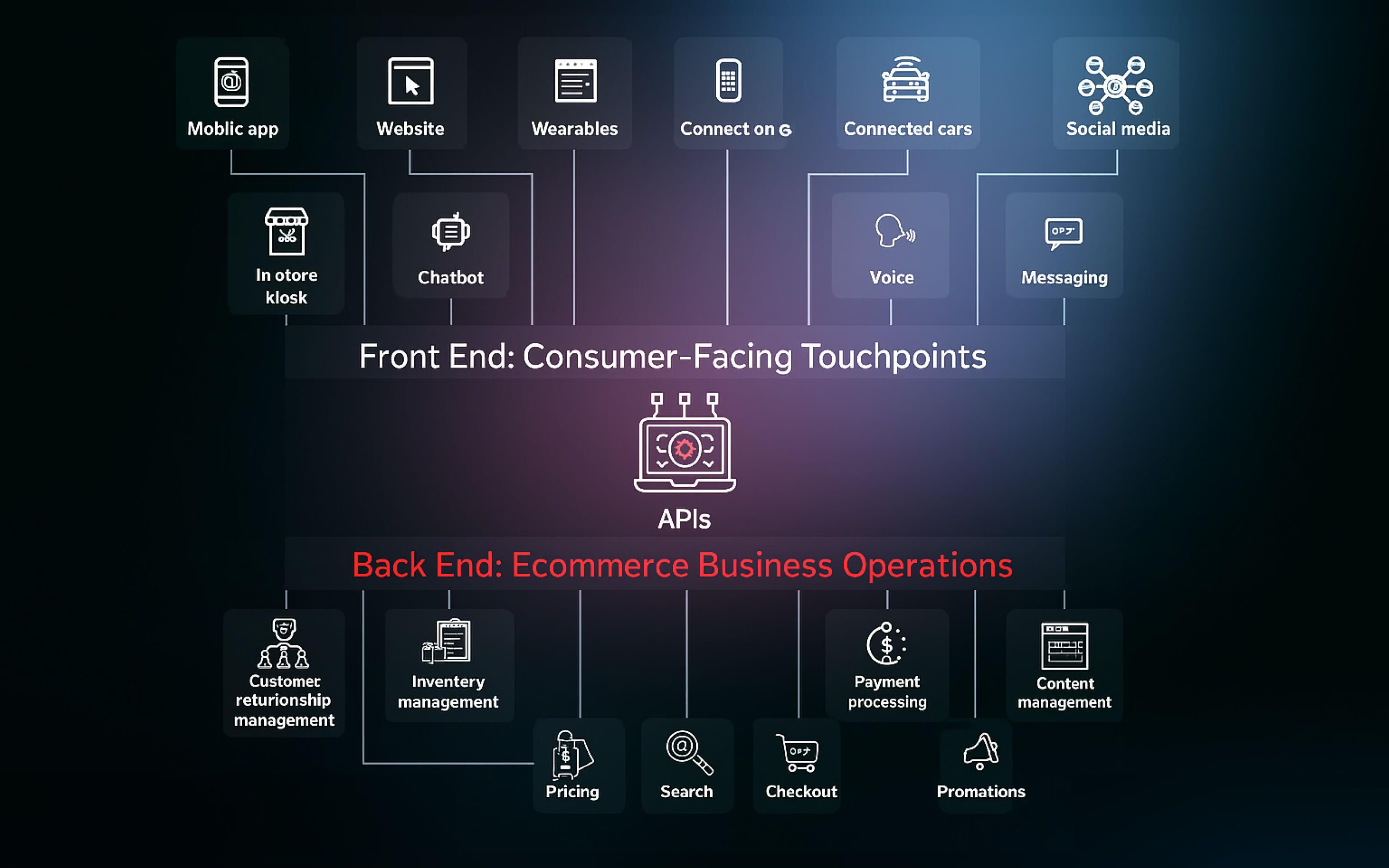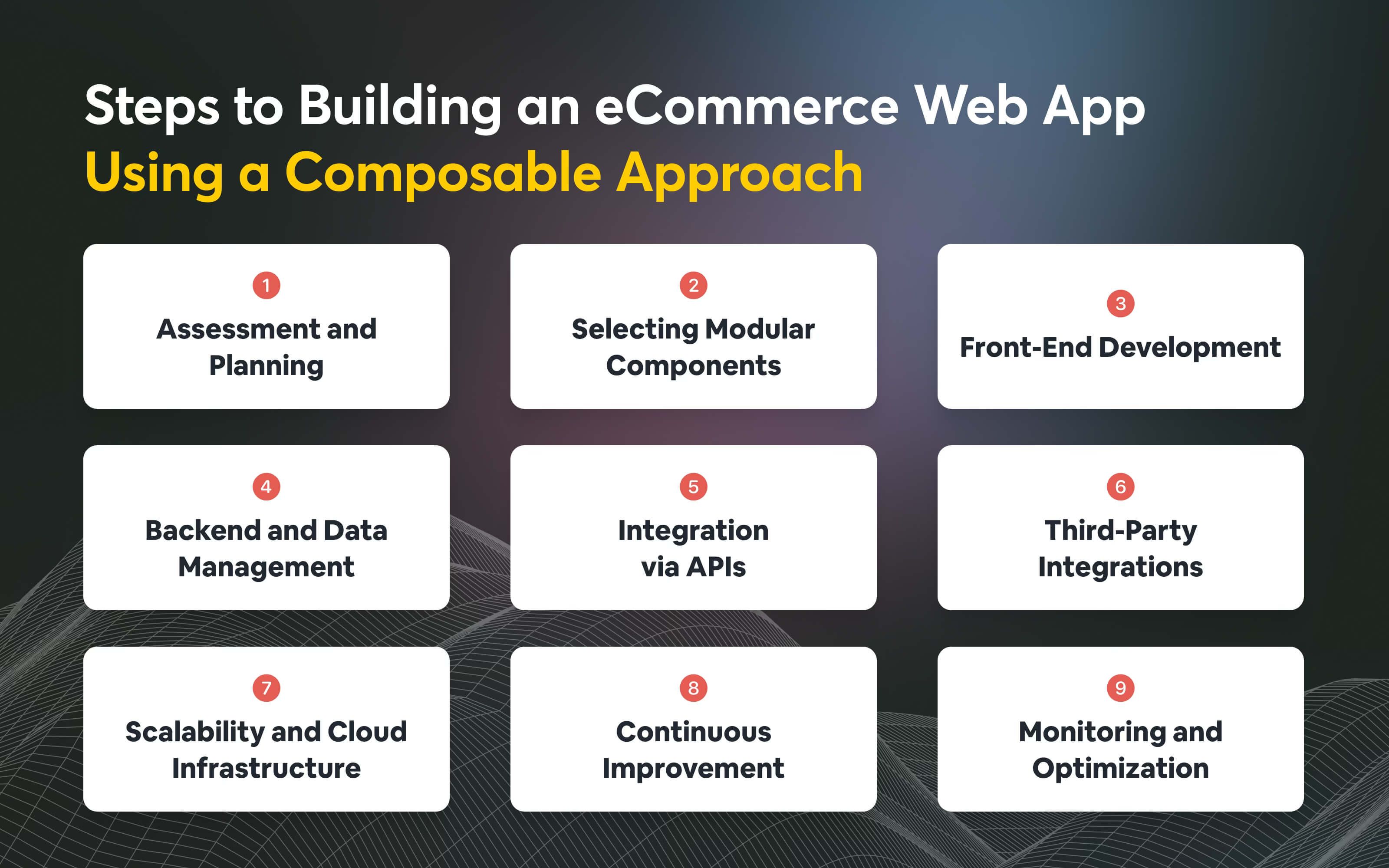The future of eCommerce is shifting away from rigid, monolithic platforms toward more agile, flexible architectures. As customer expectations continue to grow and change rapidly, businesses need solutions that allow them to adapt, scale, and innovate without being held back by legacy systems.
Composable commerce offers exactly that by enabling retailers to build their eCommerce web apps using best-of-breed components, each selected for its specific functionality and performance. This modular, API-driven architecture gives developers and business teams the agility they need to meet changing demands across web and mobile apps.
To learn more about composable commerce, we’ve prepared this guide to help you explore how it lets you build tailored eCommerce experiences —and why it’s becoming essential for digital-first businesses.
What is Composable Commerce
Composable commerce is a modular approach to building eCommerce platforms by assembling best-of-breed solutions through APIs. Unlike rigid monolithic systems, it allows businesses to independently select and integrate specialized components for checkout, search, or CMS as interchangeable building blocks.
It decouples the frontend from the backend systems, leading to agility, scalability, and faster innovation cycles. This lets businesses customize their store exactly how they want and change parts whenever needed without rebuilding everything. It's faster to add new features, easier to scale during busy periods, and allows using the best tools for each job.
Moreover, Teams can replace or upgrade individual services without affecting the entire system, making composable commerce ideal for agile, customer-centric strategies. Salesforce reports that 46% of IT teams have already adopted composable commerce, while another 43% are planning to implement it soon.
Key Benefits of Composable Commerce

Composable commerce empowers businesses to build flexible, scalable eCommerce solutions by integrating modular components tailored to their needs. Unlike monolithic platforms, it offers greater agility, faster innovation, and enhanced customer experiences. Below are the key benefits it brings to both businesses and customers.
For Businesses
- Flexibility to Choose Best-in-Class Tools: Select and integrate the best solutions for each business need, from payments to product recommendations.
- Faster Time-to-Market: Quickly launch new features or updates without disrupting existing systems.
- Scalability: Easily scale up or down based on business growth or seasonal demands.
- Faster Innovation: Add, replace, or upgrade individual components without affecting the whole system.
- Cost Efficiency: Pay only for the services you need and scale them as necessary, optimizing cost control.
- Agility: Respond to changing market conditions and customer needs more quickly.
For Customers
- Personalized Shopping Experience: Customers enjoy a highly tailored experience with relevant product recommendations and content.
- Faster, Seamless Checkout: Integration with various payment systems ensures a smooth and fast checkout process.
- Consistent Cross-Channel Experience: Whether on mobile, web, or in-store, customers experience a consistent journey.
- Real-Time Updates: Customers can access up-to-date product availability, pricing, and offers instantly.
- Increased Reliability: Seamless integration ensures fewer disruptions and better performance, leading to higher customer satisfaction.
- Omnichannel Accessibility: Customers can shop anytime, anywhere, with experiences optimized across all devices.
Explore: How to Create Visually Stunning Web Applications that Engage and Inspire Users
Key Principles of Composable Commerce
Composable commerce is built on the MACH architecture—Microservices, API-first, Cloud-native, and Headless. MACH provides flexibility, scalability, and speed, empowering brands to innovate quickly and respond to customer demands efficiently.
Microservices
Microservices divide the eCommerce system into small, independent services. Each service can be developed, deployed, and scaled separately. This modularity allows for faster updates, improved fault isolation, and the ability to swap or upgrade specific components without affecting the entire system.
API-first Architecture
API-first means that every component of the ecommerce system is accessible via APIs. This approach helps in seamless communication between services and makes it easier to connect front-end experiences with back-end logic. Overall, it promotes flexibility, simplifies integration with third-party tools, and enables faster development across channels and devices.
Learn more about: API-First Development: The Future of Modern Web App Development
Cloud-native Scalability
Cloud-native architecture enables businesses to run and scale efficiently in cloud environments. It supports elastic scalability, high availability, and faster deployments. Cloud-native systems can handle traffic spikes effortlessly, reduce infrastructure maintenance, and lower operational costs by leveraging auto-scaling and managed services.
Headless Commerce
Headless commerce decouples the front-end (UI/UX) from the back-end systems. This gives developers full control over how content and commerce are presented across devices. It enables faster updates, personalization, and omnichannel consistency—empowering brands to deliver seamless, engaging experiences across web, mobile, and more.
Difference Between Composable and Monolithic Approach in E-Commerce Apps
The composable and monolithic approaches to eCommerce app development differ in structure and flexibility. While monolithic systems are integrated as a single platform, composable systems are made up of modular components that can be customized and replaced. The table below outlines the key differences between these approaches.
| Aspect | Composable Commerce | Monolithic Commerce |
|---|---|---|
| Architecture | Modular, flexible, API-first | All-in-one solution, tightly integrated |
| Flexibility | Highly flexible, can mix and match services as needed | Less flexible, limited by the capabilities of the platform |
| Customization | Highly customizable with best-of-breed tools and services | Customization is limited to what the platform allows |
| Scalability | Easily scalable due to modular components and cloud-native | Difficult to scale quickly, often requires platform upgrades |
| Time-to-Market | Faster updates and features with independent components | Slower due to the need to upgrade the entire system |
| Integration | Seamless integration with third-party tools via APIs | Limited integration options without major customization |
| Cost | Can be more cost-effective in the long run due to pay-for-what-you-use model | Higher upfront costs for a full solution |
| Use Cases | Best for businesses wanting flexibility and rapid innovation | Suitable for small to medium businesses looking for simplicity |
How Composable Commerce Architecture Works

Composable commerce architecture works by integrating modular, independent components through APIs, allowing businesses to select the best tools for each function. These components can be easily swapped or upgraded without affecting the entire system, providing flexibility and scalability.
1. Front End: Consumer-Facing Touchpoints
These are all the channels customers interact with, such as:
- Mobile app
- Website
- Wearables
- Connected cars
- Social media
- Voice interfaces
- Messaging apps
- Chatbots
These touchpoints are decoupled from the backend, allowing for tailored experiences per platform.
2. Middleware: APIs
- APIs connect the front end to the back end.
- They allow for seamless communication, data exchange, and functionality across modules.
- This API-first approach enables real-time integration and customization without disrupting the entire system.
3. Back End: eCommerce Business Operations
This layer contains modular business capabilities, including:
- Customer Relationship Management
- Tied to the product catalog
- Inventory Management
- Includes pricing and availability
- Search Functionality
- Payment Processing
- Checkout
- Content Management
- Includes promotions
Each function is independent but interoperable, meaning businesses can mix and match tools or services as needed. Overall, composable Commerce enables businesses to build a custom, scalable e-commerce stack by assembling interchangeable services. The architecture decouples user interfaces from business logic and operations, allowing brands to deliver unified yet personalized omnichannel experiences.
Challenges of the Monolithic Approach in Ecommerce Platforms
Below, we’ve outlined the challenges of the monolithic approach in ecommerce platforms:
Lack of Flexibility
eCommerce businesses need flexibility to quickly adapt to changing customer demands, launch new features, or integrate with emerging technologies. Monolithic systems often lack this flexibility, as changes in one part of the system require significant adjustments across the entire platform, slowing down innovation and customization.
Scalability Limitations
As businesses grow, they often face increased traffic and more complex demands. In a monolithic system, scaling the entire platform can be inefficient and costly, making it harder to handle high traffic volumes, add new product categories, or support expanding user bases without significant rework or downtime. It also leads to a frustrated user experience, poor site performance, and missed sales opportunities.
Slow Innovation and Deployment Cycles
In eCommerce, the ability to launch new features quickly, such as promotions, new payment methods, or personalized recommendations, is critical. Monolithic platforms require extensive testing and updates across the entire system, leading to longer deployment cycles. This slow pace prevents businesses from responding to market changes or customer preferences in real time.
Vendor Lock-In
Monolithic eCommerce platforms often bind businesses to a single vendor for both front-end and back-end solutions, limiting options for integrating third-party tools or changing service providers. This lock-in can prevent businesses from taking advantage of newer, more efficient technologies or lower-cost solutions, restricting growth and innovation.
High Costs Due to Bundled, Unused Features
Many monolithic eCommerce platforms come with bundled features that businesses may not need. For example, a platform might include tools for managing content, inventory, and customer service, but not all businesses use these. Paying for unnecessary features increases the overall cost of ownership, limiting the budget for more critical investments like customer experience improvements.
Limited Customization Options
eCommerce platforms need to offer a personalized experience for their users, but monolithic systems often limit customization. Since the components are tightly coupled, adapting the platform to unique business needs, such as special shipping workflows or custom product configurations, is complex, time-consuming, and costly.
Performance Bottlenecks
In a monolithic eCommerce platform, performance bottlenecks can occur when multiple components (like product listings, payment gateways, or customer reviews) are tightly integrated. A slowdown in one part of the system can affect the entire user experience, leading to slow page loads and cart abandonment, which can hurt conversion rates.
Difficult Integrations with Modern Tools
As eCommerce businesses adopt modern tools for marketing automation, CRM, or advanced analytics, integrating these systems with a monolithic platform can be a challenge. The lack of flexibility in a monolithic system makes it difficult to integrate with modern tools, preventing businesses from optimizing their operations or enhancing the customer experience.
Risk of System-Wide Failure Due to Tightly Coupled Architecture
eCommerce platforms depend on multiple interconnected systems (inventory, payment processing, order management) working seamlessly. In a monolithic setup, if one part of the system fails, it can bring down the entire platform, resulting in downtime, lost sales, and customer dissatisfaction. For businesses with high transaction volumes, this risk is particularly detrimental.
Complex and Time-Consuming Updates or Maintenance
Regular updates, security patches, and feature enhancements are essential for keeping an eCommerce platform competitive. In a monolithic system, updating or maintaining the platform often requires testing and modifying the entire system. This process is slow and can result in extended downtime, potentially disrupting the shopping experience and damaging customer trust.
How Composable Commerce Overcomes the Challenges of Traditional Ecommerce
Composable commerce changes the game by letting you build eCommerce experiences using interchangeable components. Instead of relying on a rigid monolith, developers can choose and assemble only what’s needed — faster, leaner, and more future-ready. This modular approach offers agility, scalability, and freedom to innovate. It’s a shift from “one size fits all” to “build what fits best.”
1. Flexible Feature Development
Composable commerce empowers businesses to develop and deploy new features independently, without disrupting existing functionalities. Using a modular architecture, developers can integrate specialized microservices for payments, search, or checkout, enabling continuous innovation. This flexibility ensures that brands can quickly respond to customer feedback, test new ideas, and roll out updates without extensive downtime.
Unlike monolithic platforms, where changes require full-system overhauls, composable commerce supports iterative improvements, reducing risk and accelerating time-to-market. Businesses can experiment with AI-driven recommendations, AR try-ons, or voice commerce, staying ahead of competitors while maintaining a stable core infrastructure.
2. Enhanced Mobile Commerce Experience
Mobile commerce is critical for modern shopping, with 72.9% of global eCommerce sales now coming from mobile devices. Additionally, mobile-optimized sites see conversion rates 3x higher than non-optimized ones. However, rigid platforms struggle with slow performance, clunky navigation, and delayed updates that frustrate users. Composable commerce solves these challenges through headless architectures that deliver lightning-fast mobile experiences.
API-driven microservices enable instant feature updates without app store delays, while unified backends maintain seamless omnichannel sync. With personalized mobile experiences, businesses can improve user experience, respond to user behavior, and scale seamlessly, ensuring mobile commerce is not only engaging but also conversion-focused.
3. Seamless Integration with Third-Party Tools
Modern eCommerce relies on a diverse ecosystem of tools—payment gateways, CRMs, ERPs, and marketing automation platforms. Composable commerce simplifies integrations through standardized APIs, eliminating compatibility headaches. Businesses can easily connect Shopify with Salesforce, Stripe with Adobe Commerce, or HubSpot with a custom CMS.
This interoperability ensures that data flows seamlessly between systems, enabling unified reporting, personalized marketing, and efficient order management. Unlike monolithic platforms that force reliance on built-in features, composable commerce lets brands choose best-in-class solutions for each function, enhancing efficiency and reducing vendor lock-in.
4. Personalized User Experiences Across Channels
Today’s shoppers expect tailored experiences, whether browsing on mobile, desktop, or in-store. Composable commerce unifies customer data from multiple touchpoints, enabling real-time personalization. AI-powered engines analyze behavior to serve dynamic product recommendations, targeted promotions, and localized content.
Brands can create consistent omnichannel journeys, like curating wishlists that sync across devices or sending abandoned cart emails with personalized discounts. They can also increase engagement, loyalty, and average order value while reducing irrelevant messaging that drives customers away.
5. Real-Time Updates and Scalability
Seasonal spikes, flash sales, and viral traffic demand scalable infrastructure. Composable commerce leverages cloud-native architectures that auto-scale to handle surges without crashes. Real-time APIs ensure inventory, pricing, and promotions stay synchronized across all channels, preventing overselling or outdated listings.
Unlike legacy systems that struggle with high traffic, composable setups use distributed databases and edge computing for reliability. Brands can also roll out instant updates, like geo-based pricing or holiday themes, without downtime. As a result, it allows businesses to build scalable solutions, which can grow without costly migrations or performance bottlenecks.
6. Improved Developer Productivity
Monolithic platforms often require developers to work around rigid codebases, slowing innovation. Composable commerce, with its API-driven microservices, promotes reusable components and DevOps automation. Teams can independently update checkout flows, search algorithms, or CMS modules without breaking other systems.
CI/CD pipelines enable faster testing and deployment, while serverless computing reduces backend maintenance. Moreover, developers spend less time fixing legacy issues and more time building competitive features, like voice search, blockchain-based loyalty programs, or AI chatbots. This efficiency accelerates digital transformation and attracts top tech talent seeking modern, agile work environments.
7. Better Experimentation and Innovation Cycles
In fast-moving eCommerce, stagnation means losing to competitors. Composable commerce allows businesses to test new features, like subscription models, NFT integrations, or live shopping—in isolated environments before full rollout. Additionally, APIs enable rapid prototyping, while feature flags control gradual releases.
Failed experiments can be rolled back without system-wide disruptions. Furthermore, this iterative approach fosters a culture of innovation, where data-driven decisions replace guesswork. Brands can stay ahead by adopting emerging trends faster than monolithic competitors constrained by slow upgrade cycles.
8. Cost Optimization Through Modular Licensing
Traditional eCommerce suites often charge for unused features, inflating costs. Composable commerce follows a pay-as-you-grow model, where businesses only license necessary components. Cloud-based microservices reduce infrastructure expenses, while API economies allow swapping tools as needs change.
This modularity prevents vendor lock-in and enables cost-efficient scaling—startups can begin lean, while enterprises avoid bloated legacy fees. Overall, by optimizing spend, brands reinvest savings into growth initiatives like marketing, R&D, or customer experience enhancements.
Steps to Building an eCommerce Web App Using a Composable Approach

The process of composable commerce involves creating a flexible, modular eCommerce architecture by integrating various independent services and components that work together seamlessly. Here’s a breakdown of the typical steps involved:
1. Assessment and Planning
Start by identifying your business requirements, customer needs, and key goals for your eCommerce platform. Choose the right tools, technologies, and services that align with your objectives, ensuring your solutions support your goals.
2. Selecting Modular Components
Select best-of-breed services for each functionality, such as CMS, search, cart, payments, and PIM. Each component is independent, so you can replace or upgrade them without impacting the rest of the system.
3. Front-End Development
Build your front-end using frameworks like React or Vue.js for web apps. These tools support component-based design and dynamic rendering, enabling fast, responsive user interfaces. Customize the UI to create personalized experiences that engage your users.
4. Backend and Data Management
Set up backend systems for data storage, business logic, and user management, enabling seamless integration with front-end services. This is crucial for smooth performance.
5. Integration via APIs
Use APIs to connect various microservices and components, allowing them to communicate and share data in real-time, ensuring smooth operation across the platform.
6. Third-Party Integrations
Integrate external services such as CRM, ERP, marketing tools, or payment gateways to extend your platform's functionality. This allows you to connect to various business systems and services.
7. Scalability and Cloud Infrastructure
Host your solution on cloud platforms like AWS, Azure, or Google Cloud to ensure scalability, flexibility, and reliability, making your system adaptable to growth.
8. Continuous Improvement
Utilize DevOps and CI/CD pipelines to deploy updates, test new features, and ensure consistent delivery of improvements. This helps maintain the agility of your platform.
9. Monitoring and Optimization
Regularly monitor performance and optimize components based on user feedback and market demands. This will help you adapt to changes and improve the user experience.
Real-World Use Cases of Composable Commerce
Below are the real-world examples of two famous retail brands that adopted the composable commerce approach:
Sephora
Sephora leverages composable commerce to deliver consistent and rich experiences across mobile apps, websites, and in-store devices. Moving away from a rigid legacy system, Sephora adopted a composable architecture to better adapt to changing customer expectations and technology trends.
This approach allows them to integrate specialized services, like loyalty programs, product recommendations, and virtual try-ons through APIs, creating more personalized and engaging shopping journeys. With this flexibility, Sephora can scale efficiently, roll out new features faster, and ensure a high-performing, reliable experience across every customer touchpoint.
Key Results:
- Personalized UX with smart product suggestions
- Integration of beauty tech (AR, AI) into eCommerce
- Smooth omnichannel engagement and loyalty
Nike
Nike adopted composable commerce to modernize its digital infrastructure and meet the growing demand for personalized, high-performance experiences. By leveraging a headless architecture and integrating modular services for content, checkout, search, and personalization, Nike gained the flexibility to innovate faster across global markets.
As a result, regional teams were able to tailor experiences without affecting the core system, reduced time-to-market for new features, and ensured consistent, seamless brand interactions across mobile apps, websites, and in-store digital touchpoints.
Key Results:
- Faster time-to-market for campaigns
- Scalable global rollout
- Consistent omnichannel experience
Conclusion
To sum up, composable commerce is reshaping how modern eCommerce apps are built and managed. By moving away from rigid, all-in-one platforms, businesses gain the freedom to choose and connect the tools that best fit their needs. This modular approach makes it easier to launch new features, improve performance, and deliver better customer experiences across channels.
Additionally, it also allows teams to react faster to market changes and stay ahead of evolving trends. As shoppers expect more seamless and personalized interactions, having a flexible and scalable foundation becomes essential. Adopting composable commerce is no longer just an option—it’s a smart strategy to build future-ready, competitive digital shopping experiences.











